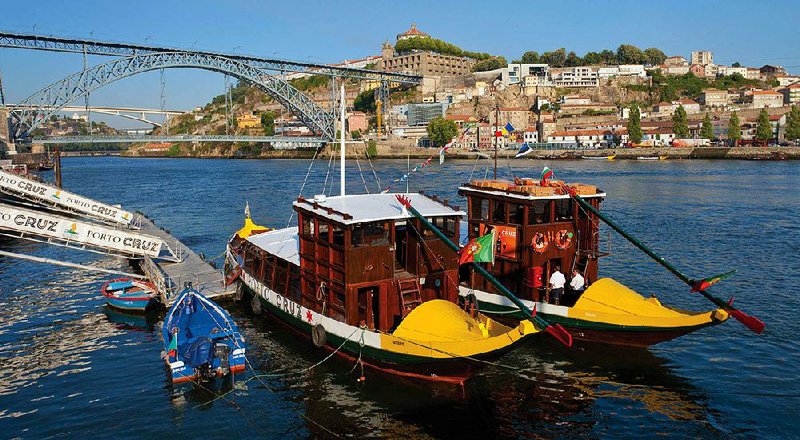Porto ages happily on the Douro River, along with most of the world's port wine, near where the river meets the Atlantic Ocean. Porto comes with a steady sea breeze and a seagull soundtrack. Discount airlines like Ryanair now fly straight to the city, putting it within easy reach of budget travelers.
To get a complete picture of Portugal, include a trip to Porto, the country's capital in the north and the second-biggest city after rival Lisbon (three hours away by train).
Gritty, hardworking Porto is less cosmopolitan than Lisbon, but it's also full of charm. The city offers two high-impact sightseeing thrills: the postcard-perfect ambience of its riverfront Ribeira district and the opportunity to learn more about (and enjoy) the port wine that ages here. Porto also has sumptuous churches, worthwhile museums, beautifully tiled buildings (even the train station), and a bustling Industrial Age market hall. You can be on a diet, but your camera will eat up the market with gusto.
The Ribeira (literally "riverbank") district is the most colorful and touristy quarter, with the highest concentration of postcard racks and good restaurants. Strolling the Ribeira embankment, while popping in and out of shops that line the way, is Porto's best lazy afternoon activity for travelers and locals alike.
Old arcades line the Ribeira promenade, and behind them are skinny, picturesque houses draped with drying laundry fluttering like proud flags. Locals stand on their little balconies gossiping. The contrast of bright tourism and vivid untouched neighborhoods within 30 yards of each other is amazing. Exploring the back streets of Porto, the depth, light, well-worn people and once-dazzling facades ferment into a nice glass of port for the eyes.
Downtown Porto is compact but steep, making distances seem longer. Foot-weary travelers take the "Six Bridges" cruises (operated by several companies, each charging about $14) that leave continually from the Ribeira riverfront. These relaxing one-hour excursions float up and down the Douro River, offering a fine orientation and glimpses of all of Porto's bridges, including the majestic steel Ponte Dona Maria Pia by Gustav Eiffel, architect of the famous French tower. The boats, which generally run daily in summer until early evening, come in two types: modern cruise boats and the smaller, traditional "rabelos." These flat-bottom boats once provided the only way to transport port wine from the Douro River Valley to Porto.
Many people don't realize that port originated in "Port-ugal." Port was a British phenomenon, invented by Brits who added grape brandy to wine to maintain its quality during the long sea voyage from Portugal to Britain.
For wine connoisseurs, touring a port-wine lodge and sampling the product is a must-see attraction. Across the river from Porto are 18 lodges open for touring and tasting. At any lodge, the procedure is about the same; individual travelers simply show up and ask for a tour. Sandeman, the most high-profile company, is sort of the Budweiser of port -- a good first stop for novices. Several tasting spots in downtown Porto, including the Port and Douro Wines Institute, are more convenient, though they lack the wine-cellar experience.
Many Americans consider port an acquired taste. For this reason, many port producers along the Douro also make a more straightforward red wine. But as I always say, "Any port in a storm."
Recently I enjoyed taking a food tour in Porto. These tours are trendy throughout Europe. They cost around $70, are timed for an early lunch or dinner, last around three hours, come with more than a mile of walking and include four to eight stops. The tours are pricey, but if you think of them as a meal as well as a tour, they make the splurge easier to justify. In Porto, I went with the Taste of Porto Food and Wine Tours, run by Andre, who enjoys his work so much that he'll do a tour even if just one person shows up.
When dining in Porto, you'll notice that some restaurant menus have two price columns; the cheaper list is for half-portions ("meia dose" -- plenty for one person), and the higher-priced list is for full portions ("dose" -- easily feeds two people). Be warned: As is common throughout Portugal at restaurants with wait staff, waiters may bring you appetizers you didn't order. Wave them away or you'll be charged for them.
Porto natives are known as "tripeiros" (tripe-eaters), compared to Lisboans who've been dubbed cabbage-eaters, but fortunately everyone in Portugal likes cod. Along with tripe, there's plenty of seafood and meat on Porto menus. A favorite sandwich is the "francesinha," which is like a Portuguese French dip with a tomato-based sauce. Picnic sandwiches and scenic perches -- for people-watching, views or both -- are easy to come by in lively Porto.
Whether you're enjoying Ribeira's riverfront promenade, cruising the Douro, or sampling port in this port city, Porto gives you a fine taste of authentic Portuguese culture.
Send email to Rick Steves at
rick@ricksteves.com
Travel on 12/14/2014
